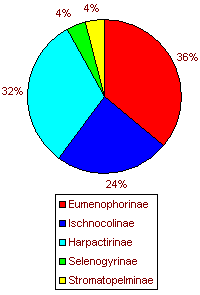History:
In 1793 the danish Entomologist Johan Christian FABRICIUS (*1745 - †1808) described the first tharaphosid from Africa, Aranea calceata. At that time Systematics was not on the level as it is today and all spiders have been put into the genus Aranea. Later for this species a genus named Scodra BECKER, 1879 was created. The generic name Scodra was however occupied by the butterfly genus Scodra HEINEMANN 1859. It was later renamed to the next recent synonym Stromatopelma KARSCH, 1881.
 At present the African bird spider fauna covers 168 species in 30 genera. These were described mainly in the time between 1870 and 1930. In the period between 1890 and 1910, in only 20 years, over 90 species descriptions have been published. Between 1910 and 1990 only very few species habe been described. Starting from the 90ern until today there is an improvement, which we have to owe to R. C. GALLON, because he intensively works on Baboon Spiders for over five years.
At present the African bird spider fauna covers 168 species in 30 genera. These were described mainly in the time between 1870 and 1930. In the period between 1890 and 1910, in only 20 years, over 90 species descriptions have been published. Between 1910 and 1990 only very few species habe been described. Starting from the 90ern until today there is an improvement, which we have to owe to R. C. GALLON, because he intensively works on Baboon Spiders for over five years.
The subfamilies containing the most species are the Eumenophorinae (POCOCK, 1897) and Harpactirinae (POCOCK, 1897) with approximately a third (36% and 32%) each. The subfamily Ischnocolinae (SIMON, 1892) containes approximately a quarter (24%). The two subfamilies Selenogyrinae (SMITH, 1990) and Stromatopelminae (SCHMIDT, 1993) share the remaining 8%. In comparison to the world-wide distribution of theraphosids Baboon Spiders cover a part of approximately a fifth (20%). As one sees probably more Therphosids come from the black continent as one might assume in the first moment.
Harpactirinae (POCOCK, 1897):
In 1897 Reginald Innes POCOCK set up the subfamily Harpactirinae. In the same work he also created, apart from other genera and species, the genus Ceratogyrus with the species C. darlingi and C. marshalli as well as the genus Pterinochilus with the species P. murinus and to P. vorax.
The first modern revision of a genus of the subfamily was done by J. I. DE WET & A. S. DIPPENAAR SCHOEMAN in 1991 on the genus Ceratogyrus.
In 2001 Richard C. GALLON revised this genus again and synonymised the genus Coelogenium PURCELL, 1902 with Ceratogyrus.
In the following year, R. C. GALLON published a revision of the genera Pterinochilus and Eucratoscelus and 6 Pterinochilus species remained of the formerly 22 species.
The next revision within the Harpactirinae on which R. C. GALLON momentarily works will treat the genera Harpactira and Harpactirella. Possibly the genus Brachionopus* will be transferred to the Barychelidae.
Right now there are 58 described species in 8 genera:
- Augacephalus GALLON, 2002: 2 species
- Brachionopus* POCOCK, 1897: 5 species
- Ceratogyrus POCOCK, 1897: 11 species
- Eucratoscelus POCOCK, 1898: 2 species
- Harpactira AUSSERER, 1871: 16 species
- Harpactirella, PURCELL, 1902: 13 species
- Idiothele HEWITT, 1919: 1 species
- Pterinochilus POCOCK, 1897: 7 species
- Trichognathella GALLON, 2004: 1 species
*The genus Brachionopus POCOCK, 1897 was transferred into the family Barychelidae by GALLON, 2002 versus CHARPENTIER, 1993 and SCHMIDT, 2002a . Since no clear allocation was made, GALLON speaks of it that the genus does not fit into a well-known subfamily of the Barychelidae, the genus is still treated as incertae sedis. Norman I. PLATNICK however does not yet recognize this and for the time being leaves the genus Brachionopus in the family Theraphosidae. A final transferring into the family Barychelidae is considered only after further investigations and their publication.
Keyfeatures of the Harpactirinae:
- Medium to small theraphosids with dorsal abdominal pattern consisting of bars, spots and reticulations. (f.e. A. junodi
 )
)
(Exception: obscure or absent in Eucratoscelus and some Harpactira) - Retrolateral face of the chelicerae with district plumose scopula. (f.e. P. chordatus
 )
)
((Exception: absent of retrolateral cheliceral plumose scopula in Harpactirella). The genera Harpactira and Trichognathella possess accessorily scopula on the prolateral face of the chelicerae. This scopula is plumose in Harpactira and non-plumose in Trichognathella. Note: The subfamily Ornithoctoninae also possess retrolateral cheliceral scoupla but differs from the Harpactirinae in the structure of the stridolatory organs. - The spermathecae is made up of two Receptacula seminis.
(f.e. P. chordatus
 )
)
(In Eucratoscelus, Harpactira, Harpactirella and some Pterinochilus with terminal lobes (f.e. P. lugardi ))
)) - Fovea straight or slightly procurved.
((Exception: most Ceratogyrus possess a strongly procurv fovea, often with foveal protuberance (f.e. C. marshalli ))
)) - Distal segment of posterior spinneret digitiform. (f.e. P. chordatus
 )
)
(Exception: Idiothele possess a sub-conical distal segment (f.e. I. nigrofulva ))
)) - All tarsi with integral scopulae. (f.e. P. chordatus
 )
)
(Exception: In part non-integral in Harpactirella) - Metatarsal scopulae of legs I;III integral. (f.e. P. chordatus
 )
) - Metatarsal scopula of leg IV bisected longitudinally by band of stiffened setae. (f.e. P. chordatus
 )
) - Male tibial spur on leg I is made up of a single megaspine.
(f.e. P. murinus )
(Exception: absent or reduced only in the genus Augacephalus (f.e. A. breyeri
)
(Exception: absent or reduced only in the genus Augacephalus (f.e. A. breyeri  ))
))
